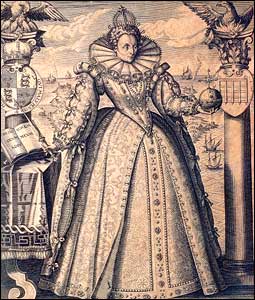|
|
|
|

Introduction to The Ocean, to Cynthia
by Anniina Jokinen
"The Ocean's Love to Cynthia," or, "The Ocean, to Cynthia," is a long elegy written to celebrate Queen Elizabeth I as Cynthia.1 Ralegh never published it, and no complete manuscript exists, but the complete poem, if indeed it ever reached completion, is thought to have contained nearly 15,000 lines of verse.2
It was thought to have been destroyed, when a manuscript of 568 verses was found with the Hatfield manuscripts, bearing the description "The twenty-first and last book of the Ocean, to Cynthia." The manuscript ends abruptly in the midst of the beginning of a final poem, the "22nd book, entreating of sorrow." The fragment was first printed by J. Hannah in 1870.
Scholars have fruitlessly sought a composition date for the poem, and while little consensus exists, it is near certain that the composition took place before Elizabeth's death in 1603. As Stebbing pointed out, "Ralegh would not have sat down in the reign of James to write love ditties to Elizabeth."3 Perhaps the reason the manuscript ends so abruptly is exactly that — perhaps the Queen passed away before the poem was completed, and Ralegh saw no point to finishing it.
While the exact dates of composition are not known, it can be conjectured that Ralegh had a fully conceived notion of the entire work, and perhaps some finished sections, before 1591, when his friend, Edmund Spenser, mentions Ralegh — as "The Shepheard of the Ocean," who had written of the "usage hard,/ Of Cynthia, the Ladie of the Sea" — in his Colin Clout (printed in 1595, but inscribed to Ralegh in 1591). Stebbing believed the extant twenty-first book to have been, most likely, composed between the years 1592-1595.
We will perhaps never know the exact composition dates, nor possess the complete manuscript, if such ever existed. Yet the extant lines of Cynthia paint a vivid picture of the beauty and magnificence of the complete work, as it may have been. While rarely printed, it remains one of Ralegh's loveliest works, and shows what a poet Ralegh might have been, had he dedicated himself solely to writing, and not been driven to seek his fortune as an explorer and soldier.
1 Cynthia, one of the names of the Greek goddess Artemis,
goddess of the moon and the hunt, the epithet "Cynthia"
deriving from Artemis' birth place of Mount Cynthus. Her
Roman counterpart was Diana, another of the names often
used in poetry to flatter the "Virgin Queen" Elizabeth.
2 Creighton, Louise. "Cynthia, and other poems."
The Cambridge History of English and American Literature.
A. W. Ward & W. P. Trent, et al.
Cambridge: Cambridge University Press, 1907-21.
3 Stebbing, William. Sir Walter Ralegh: A Biography.
Oxford: Clarendon Press, 1891. 73.
Article citation:
Jokinen, Anniina. "Introduction to Cynthia." Luminarium.
26 Oct 2006. [Date you accessed this page].
<http://www.luminarium.org/renlit/oceanintro.htm>
 | to Works of Sir Walter Ralegh |
Site copyright ©1996-2010 Anniina Jokinen. All Rights Reserved.
Created by Anniina Jokinen on October 26, 2006. Last updated on June 9, 2010.
|
|
The Tudors
King Henry VII
Elizabeth of York
King Henry VIII
Queen Catherine of Aragon
Queen Anne Boleyn
Queen Jane Seymour
Queen Anne of Cleves
Queen Catherine Howard
Queen Katherine Parr
King Edward VI
Lady Jane Grey
Queen Mary I
Queen Elizabeth I
Renaissance English Writers
Bishop John Fisher
William Tyndale
Sir Thomas More
John Heywood
Thomas Sackville
John Bale
Nicholas Udall
John Skelton
Sir Thomas Wyatt
Henry Howard
Hugh Latimer
Thomas Cranmer
Roger Ascham
Sir Thomas Hoby
John Foxe
George Gascoigne
John Lyly
Thomas Nashe
Sir Philip Sidney
Edmund Spenser
Richard Hooker
Robert Southwell
Robert Greene
George Peele
Thomas Kyd
Edward de Vere
Christopher Marlowe
Anthony Munday
Sir Walter Ralegh
Thomas Hariot
Thomas Campion
Mary Sidney Herbert
Sir John Davies
Samuel Daniel
Michael Drayton
Fulke Greville
Emilia Lanyer
William Shakespeare
Persons of Interest
Visit Encyclopedia
Historical Events
Field of the Cloth of Gold, 1520
Pilgrimage of Grace, 1536
The Babington Plot, 1586
The Spanish Armada, 1588
Elizabethan Theatre
See section
English Renaissance Drama
Images of London:
London in the time of Henry VII. MS. Roy. 16 F. ii.
London, 1510, the earliest view in print
Map of England from Saxton's Descriptio Angliae, 1579
Location Map of Elizabethan London
Plan of the Bankside, Southwark, in Shakespeare's time
Detail of Norden's Map of the Bankside, 1593
Bull and Bear Baiting Rings from the Agas Map (1569-1590, pub. 1631)
Sketch of the Swan Theatre, c. 1596
Westminster in the Seventeenth Century, by Hollar
Visscher's Panoramic View of London, 1616. COLOR
|
|